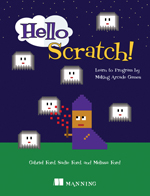MFA Sunday School (Thirteen: Haiku)
![]() Welcome to MFA Sunday School, a once-a-week, free, online writing workshop. MFA Sunday School posts are uploaded on Sunday mornings, though you can read them or participate any time — the comment section is always open for people to post a link to their work or ask a question. You can subscribe to blog posts via the RSS feed, or look for them under the category heading “MFA Sunday School.” If this is your first time in “class,” you may want to jump back to the first post in the series in order to understand how things work, or peruse all of the past lessons as well as a glossary of terms by reading the MFA Sunday School Glossary and Course Archives.
Welcome to MFA Sunday School, a once-a-week, free, online writing workshop. MFA Sunday School posts are uploaded on Sunday mornings, though you can read them or participate any time — the comment section is always open for people to post a link to their work or ask a question. You can subscribe to blog posts via the RSS feed, or look for them under the category heading “MFA Sunday School.” If this is your first time in “class,” you may want to jump back to the first post in the series in order to understand how things work, or peruse all of the past lessons as well as a glossary of terms by reading the MFA Sunday School Glossary and Course Archives.
Fixed form poetry is meant to free the mind by providing a structure much in the same way a house frees the person who lives inside to focus on things other than the elements outside. The next form we’re going to look at is the haiku.
Before you shrug your shoulders and say, “anyone can write a haiku,” I’m going to tell you that you’re correct. Anyone can write a haiku which is why they’re such a popular poetry form with the elementary school set. But few can write a good haiku. Few can use those 17 allotted syllables wisely.
Yes, I used the term syllables because I’m writing this as an American. Traditional haikus use 17 morae (not syllables) because Japanese is a language that is known for its moraic qualities. Think of mora as the length of the syllable. You can have long syllables or short syllables, and nowhere is this clearer than when you think about the different ways the British and Americans pronounce the same word.
What do college students live in? A dormitory. If you ask an American to say the word, they will give you four short syllables — dorm-i-tor-y — and we stress the first syllable slightly. If you ask someone British to say the same word, they will give you three syllables, with the third one held for two brief counts instead of one — dorm-i-try. Both words have four morae, but in one case (the British one), two mora are combined to make one syllable.
Do you see now why traditional haiku artists are cranky when we wave our hand and say, “Morae are too hard to work with! Let’s count syllables instead.” Morae are harder to work with inside English, though they aren’t as difficult to work with in Japanese, a very moraic language. There is more evenness in the time it takes to say each part of the word than there is in English.
We actually touched on this idea of morae back when we looked at meter in the villanelle lesson. Remember when I told you about the other poetic feet beyond iambs (trochee, spondee, pyrrhic, anapest, amphibrach and dactyl) — all of them are essentially counting morae. For instance, a trochee foot is three morae (though it has two syllables). It’s a stressed syllable followed by an unstressed syllable. Helpless. Help is stressed and it counts as two morae. Your mouth forms the first mora (hel) and then your lips close to say the second mora (lp). The “L” in help actually travels between the two morae. Less is unstressed and brief, and it counts as one morae. The exact opposite happens with the iamb. You have an unstressed followed by a stressed syllable. Again, iambs are comprised of three morae.
So, forgive me traditional haiku masters: since we are working in English and not in Japanese, I’m going to let everyone count syllables instead of morae. Because I’d rather have you focus on subject matter and the juxtaposition vs. get hung up on the sound of the words, especially since English doesn’t mirror Japanese.
So let’s go with the traditional count of 5, 7, and 5. In Japanese, it is 5 morae, 7 morae, and 5 morae. In English, we’ll count it as 5 syllables, 7 syllables, and 5 syllables (but now you can also understand why correct haikus often don’t follow that 5, 7, 5 syllable count — those poets are counting morae even in English.
Traditional haikus always work with juxtaposition of two images — the images push against one another and in effect, heighten one another. Let’s look at a famous haiku by Kobayashi Issa for a moment:
little snail
inch by inch, climb
Mount Fuji!
It’s also written less directly as,
- O snail
- Climb Mount Fuji,
- But slowly, slowly!
Both are translations so they don’t fit the pattern when written in English though it does in Japanese (katatsuburi / soro-soro nobore / fuji no yama). But it’s a perfect example of that idea of “kiru” (which means cutting, and is the term used to explain the way the juxtaposition should be used).
It’s a snail, a tiny thing. And then the image pulls back and we see what he’s climbing — Mount Fuji, the largest thing. Tiny meets large and tiny becomes smaller whereas the large becomes huge. That is juxtaposition or the kiru of the poem. And all haiku try to employ some type of slash that gives the reader greater understanding of the two parts.
There’s additionally a second kiru. Mount Fuji is a spiritual place and Buddhists believe it’s a gateway since it reaches up into the sky. This is a tiny snail — the lowliest of beings. It oozes. And it’s climbing… wait for it until the last morae… Mount Fuji. It’s juxtaposing this spiritual space with the tiniest being and showing the importance of all life on earth. We are all struggling to climb the figurative mountain of life, regardless of size or circumstance.
There is one last part of kiru that will be familiar to you since we just studied sonnets (see, there is a reason for the order we approached these fixed forms!). Kireji is the term for the actual slash — the element that changes your understanding. For instance, the word that separates the two images that you’re juxtaposing. It’s the Japanese version of the “turn” or “volta” you saw in the sonnet! Kireji is a cutting word or piece of punctuation. It can be as simple as a comma or as complicated as a word.
The last part is the idea of “kigo” or using something from the natural world. In this case, we’re looking at a snail and we’re looking at a mountain. And we get a sense of the season, since kigo often refers to the seasonal element of the poem. In this case, it’s spring, a time of year when snails are plentiful. (I think… I know snails hibernate, but I don’t really know a lot about the life cycle of the snail.)
Homework: try your hand at writing a haiku now that you know more about the form, and make sure you post a link in the comment section below if you publish one on your blog so we can hop over to read it.













5 comments
I love the haiku. On facebook I “haiku complain” and it’s a lot of fun. Here’s something I posted there just now…
Up before dawn. Sigh.
The currency for fun trips
abroad is jet lag.
#haikucomplaining
Here’s mine: http://twowomenblogging.blogspot.com/2012/07/mfa-sunday-school-haiku-by-jay.html
(I’m linking-impaired. Sorry)
I’ve never written a haiku. Here’s what I just wrote today
Love’s a painful thing
It leaves you breathless and hurt
It’s still life changing
I think I might make it my goal to write a haiku a day about my life
I love haiku! When I am waiting for things I come up with random words and then build haikus around them. Good time killer.
Here’s mine. It’s not good.
http://mywordshavewings.blogspot.co.nz/2012/07/assignment-haiku.html